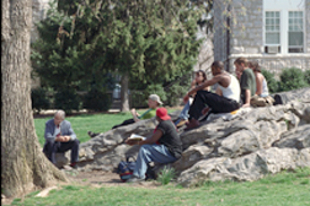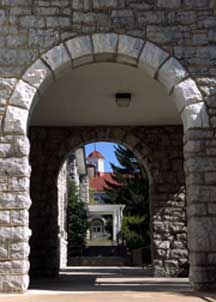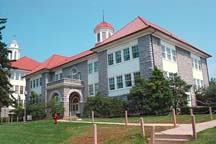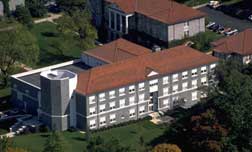
In the Shenandoah Valley, it's everywhere. It's in signature buildings and classic homes. It's in parking lots and driveways. And, chances are, you've discovered it when digging in your own yard or garden. Bluestone – it's at the very heart of the geology and history of the Shenandoah Valley.
Our forefathers used it to construct some of the most magnificent homes and buildings in the nation for over 250 years and, to this day, it's used in building and landscaping projects throughout the Shenandoah Valley. Despite its history and elegance, the production of bluestone all but ceased for many decades. But in the past ten years, a renewed appreciation for this classic Valley building stone has rekindled the interest of a local quarry company to produce it.

The History of Bluestone
Bluestone itself is a misnomer. Actually a variety of limestone, “bluestone” got its name due to its dark blue-grey color, whereas most limestones are lighter shades. The unique characteristic of Valley bluestone is that, over time, bluestone weathers to a light grey. Says Bibb Frazier of Frazier Quarry in Harrisonburg, the sole producer of bluestone in the area: ”Our stone has a geologic history. It is uniquely dark among limestone because it formed at the bottom of deep seas, where sunlight could not penetrate. Most limestone forms in shallow water, where sunlight bleaches it to a light color.”
The Shenandoah Valley sits on top of a massive bed of limestone, formed 450-500 million years ago during the Ordovician era. Several hundred million years later, the tectonic forces that formed the Appalachian Mountains also folded and compressed this bed of limestone. The forces of nature seasoned this ordinary limestone into the unique Valley bluestone. So, it can be said that, throughout history, bluestone has been the natural foundation under the Shenandoah Valley.
Bluestone In The Valley
The history of bluestone is intertwined with the history of the Shenandoah Valley. When the first settlers arrived here in 1745, they found a durable and beautiful building material under their very feet. From the beginning, bluestone was used as one of the primary building materials of homes and structures throughout the Shenandoah Valley.
And, as the population of the Valley grew, so did the use of bluestone. The fact, however, that bluestone was simply one of the most abundant building materials in this area should not speak against the superior quality of the stone, says Frazier: “The architectural heritage that comes with bluestone, along with its strength and simple beauty – these qualities reflect the very nature of the German and Scotch-Irish settlers who braved the mountains to settle in the Shenandoah Valley.”
Even while the fires of the Civil War destroyed the homes, barns and other outbuildings of Valley residents, bluestone foundations survived, making it possible for Valley families to rebuild. Bluestone has stood the test of time, and is just as sturdy and beautiful today as it was hundreds of years ago. Evidence of bluestone's endurance can be seen in the prominent homes and buildings that still stand tall throughout the Valley – from the “Bluestone Campus” of James Madison University, to the Virginia Military Institute, Washington and Lee University, Belle Grove Plantation in Strasburg and the historic downtowns of every town in the Valley. (There are currently 23 buildings at JMU constructed primarily of bluestone. Click for a listing.)

Bluestone Production and WWII
Traditionally, the production of bluestone was a laborious, time-intensive process. Workers would chisel, carry, and split massive slabs of bluestone either by hand or with the most basic machinery. Quarrying just a few tons of the dense stone would take countless hours and scores of workers.
Eventually, the increased demand for homes, schools, hospitals, etc. after World War II led to a significant shift in architectural design as building needs were met with machine-made substitutes for natural stone, such as vinyl and metal siding, split-face masonry block, and synthetic stone.
As these more economical, readily available substitutes became more prevalent, the appearance of natural stone in homes and buildings lessened. “The traditional construction techniques and materials could not keep pace with the demand at the time in terms of price, capacity, and production. Concrete, steel, and aluminum came of age after WWII as pre-eminent building materials and, in the end, the demand for traditional building bluestone diminished,” Frazier said. The builders of the time began utilizing more affordable materials, but often at the cost of the authenticity and beauty that natural stone can bring.
Frazier Quarry and the Rebirth of Bluestone
Long before World War II, the Frazier family has been dedicated to the production of natural stone products. Founded in 1912, Frazier Quarry began – and is still – a reliable, family-owned and operated business. “Even during the decline of bluestone production after WWII, Frazier Quarry has always produced Shenandoah Valley bluestone – from crushed stone to split and sawed products,” Frazier said.
In fact, the most significant aspects of Frazier Quarry that have changed over 95 years are the methods and technologies used for quarrying bluestone. If the workers from decades ago could see the high-tech quarrying methods employed by Frazier Quarry today, they would be astounded.
First, Frazier starts with only the best stone from deep within the earth where intense pressure applied over thousands of years has made the most dense, durable bluestone. In fact, Frazier Quarry's source of bluestone is the only one of its kind for hundreds of miles. To quarry the stone, Frazier Quarry employs innovative hydraulic technology and advanced quarrying methods to ensure that the deep, rich slabs are extracted precisely and efficiently. What would have taken weeks to quarry years ago can now be done in a day.
The end product is Stonewall Grey, Frazier Quarry's line of natural bluestone. What's so special about Stonewall Grey is that it's the exact same kind of stone used in landmark homes and buildings across the Shenandoah Valley, but in easy to use variations and at an affordable price.
After quarrying, Frazier Quarry employs a stone splitting and cutting system. First, Frazier utilizes a powerful stone splitter – the only one of its kind in the region. With the splitter, craftsmen hand-select and cut each piece of bluestone according to its own unique grain and texture. Cut pieces can range from thin wall-stone and flagstone to larger building blocks.
This process dramatically minimizes the amount of time and cost needed for a stonemason. Second, Frazier Quarry utilizes its state-of-the-art diamond saws. These specially-designed pieces of equipment are capable of sawing bluestone to precise dimensions, making it possible for architects to specify trim pieces such as coping stone, steps, sills, lintels – the possibilities for application are almost limitless.

Stonewall Grey: Today and Tomorrow
Evidence of the return of bluestone can be seen in construction and landscaping projects across the Valley. One prime example lies in one of the most notable sites for historic bluestone construction in the area, James Madison University. Projects like the 900-car parking deck at JMU represent a move back to the tradition of bluestone on campus. Not only is the parking deck functional, but it also embraces the architectural heritage of the University by featuring a veneer of Stonewall Grey bluestone.
“More value is being placed on tradition at JMU,” Frazier said, “the University is supporting its growth needs more and more with donations from its alumni and local residents, who appreciate the classic look of bluestone architecture.”
Bluestone has always been a part of the history at JMU: from the walls of the buildings on JMU's famous Quadrangle, to the base material in JMU's concrete, paved roads, and sidewalks. And now, a whole new era in the history of bluestone is unfolding – not only for JMU, but for the entire Shenandoah Valley.
-- Provided by Frazier Quarry
From Inside Nielsen Magazine, Spring, 2007
